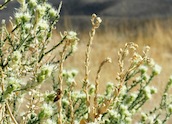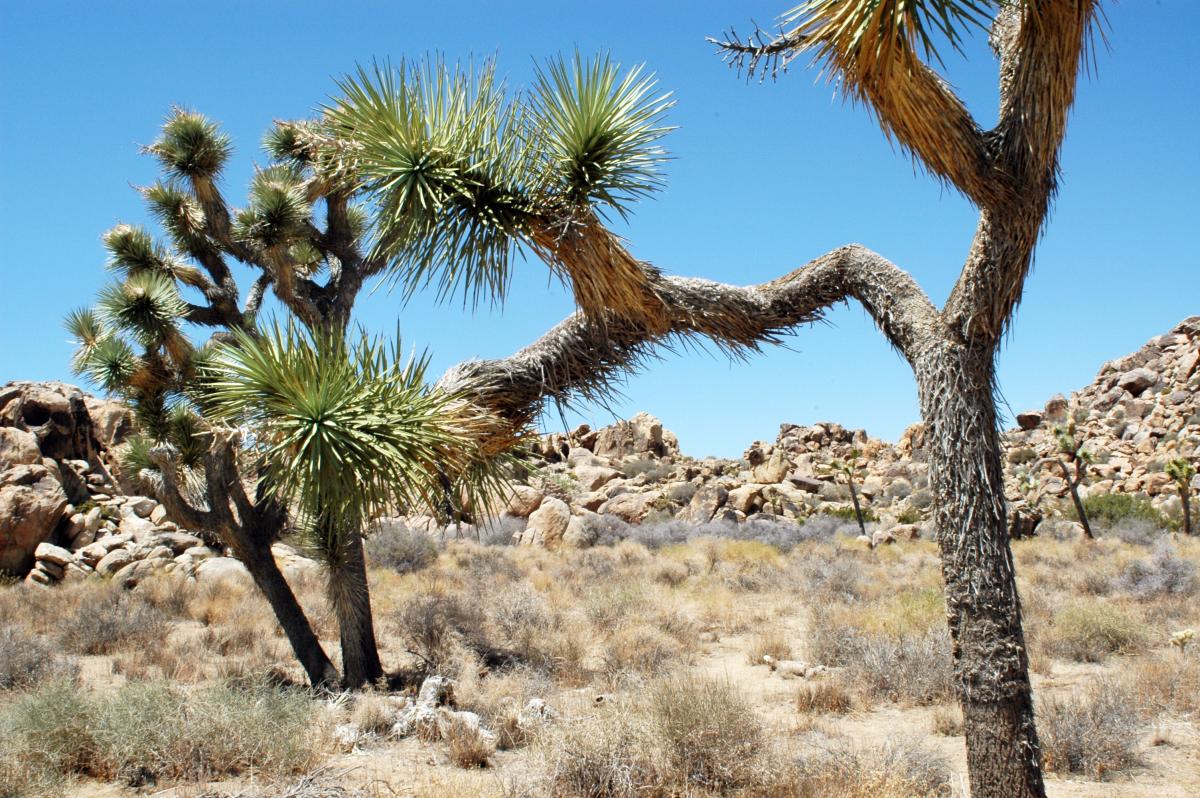
Wildflower Blooms
Pollinators provide an essential ecosystem service – pollination – to wild plants and crops worldwide. In addition to valuable crops, pollinators sustain plants that are important to natural resource-based tourism. The Mojave National Preserve, Death Valley National Park, and Joshua Tree National Park are popular tourist destination for colorful springtime wildflower blooms (Figure 6.7). Both Joshua Tree National Park and Mojave National Preserve attract visitors from around the world who come to see the distinctive Joshua tree (Yucca brevifolia). The loss of pollination services to natural ecosystems is difficult to predict. One potential impact from the loss or disruption of this service could be severe limitation of flowering plant reproduction, which could have cascading effects throughout an ecosystem.1
1 J.C. Biesmeijer, S.P.M. Roberts, M. Reemer, R. Ohlemueller, M. Edwards, T. Peeters, A.P. Schaffers, S.G. Potts, R. Kleukers, C.D. Thomas, J. Settele, and W.E. Kunin, “Parallel declines in pollinators and insect-pollinated plants in Britain and the Netherlands,” Science 313, no. 5785 (2006): 351-354.
Pollinators
Cumulative Effects from Solar Development
Utility-scale solar development could significantly contribute to habitat loss and fragmentation for pollinators in the California desert. Habitat loss has been cited as the “most universal and high impact factor driving bee declines”, with habitat fragmentation coming in second on the list.1 Without the services of reliable pollinators, flowering plant populations in habitat fragments may experience reduced seed production and lower genetic diversity.2 Solar development, at the scale that it has been proposed, would likely result in habitat loss and fragmentation for pollinators. Because most solar technologies require a zero to six percent rise in slope (a few can tolerate seven to 11 percent), much of the habitat loss will occur in lower elevation areas. The creosote bush (Larrea tridentata) that dominates these lowland areas attracts over 120 species of bees, one of the richest bee faunas of any plant in North America.3 The loss and fragmentation of several thousands of acres of a relatively common plant species could seriously affect a much wider array of pollinator biodiversity.
Habitat loss and fragmentation are not the only threats to pollinators; climate change and the invasion of non-native honeybees (Apis mellifera) that compete with native bees for pollen resources also threaten native desert pollinators.4 Even if pollinators could survive a single threat relatively unscathed, the cumulative effect of these threats compounded by solar development, could result in a decline in pollinator populations and biodiversity, with unknown effects for the rest of the California desert ecosystem.

Climate Change and Pollinators
Pollination mutualisms exist between pollinators and the plants that provide them with food or other services. For example, several moth species have co-evolved a mutualistic relationship with the plant genus Yucca (family Agavaceae), including the distinctive Joshua tree (Yucca brevifolia)(Figure 1).5 Moths simultaneously pollinate yucca flowers and lay eggs within them and the yucca seeds nourish the moth larvae once they hatch. In the Sonoran Desert, the senita cactus (Lophocereus schottii) and senita moth (Upiga virescens) have also evolved a mutualistic relationship.6,7
Global climate change could affect pollination mutualisms by disrupting the synchrony between flowering plants and pollinators.8 Shifts in phenology (i.e. flowering time) induced by climate change could reduce or eventually eliminate the temporal overlap between pollinator activity and plant flowering, potentially causing local extinction of pollinators whose activity periods no longer overlap with any of their food plants.9 Climate change could also disrupt pollination mutualisms by altering desert plant communities. Climate models show a slow warming of the Mojave and Sonoran Desert regions, and climate change is also likely to alter precipitation regimes.10,11 Changes in temperature and precipitation patterns could result in a greater production of invasive grasses and/or increased mortality of native plants; elevated fire frequencies and shifts in the distribution of plant communities are also concerns.12 Pollinator species with narrow habitat requirements and/or specialized diets may decline if certain plant species or communities become locally extinct.13
Ecological Implications for Facility Location and Design
The magnitude of impact that the development of a single solar facility or multiple facilities will have on the desert pollinators is dependent on the facility design variables and location as discussed in Table 1. These variables will influence the magnitude of the cumulative impact of solar development on the important, but not well-understood, role of these pollinators.
| Facility Design Variable | Implications for Desert Pollinators |
|---|---|
| Location of facility | Determines the quality of pollinator habitat that is eliminated (some areas are better quality habitat than others). |
| Size of facility | Larger facilities increase the probability of eliminating pollinator habitat. |
| Proximity to other development (solar and other) | Determines the magnitude of habitat fragmentation. |
| Land-use efficiency | Determines a facility's contribution to off-setting net carbon emissions and reducing the impacts of climate change on pollinators while minimizing impacts to pollinators from habitat loss and fragmentation. |
1 M.J.F. Brown and R.J. Paxton, “The conservation of bees: a global perspective,” Apidologie 40, no. 3 (2009): 410-416.
2 J.H. Cane, J.H., R.L. Minckley, L.J. Kervin, T.H. Roulston, and N.M. Williams, “Complex responses within a desert bee guild (Hymenoptera: Apiformes) to urban habitat fragmentation,” Ecological Applications 16, no. 2 (2006): 632-644.
3 J.H. Cane, J.H., R.L. Minckley, L.J. Kervin, T.H. Roulston, and N.M. Williams, “Complex responses within a desert bee guild (Hymenoptera: Apiformes) to urban habitat fragmentation,” Ecological Applications 16, no. 2 (2006): 632-644.
4 Robert Fulton, Manager, California State University Desert Studies Center, Personal Communication, October 20, 2010.
5 J.A. Powell, “Interrelationships of Yuccas and Yucca Moths,” Trends in Ecology & Evolution 7, no. 1 (1992): 10-15.
6 J.N. Holland and T.H. Fleming, “Mutualistic interactions between Upiga virescens (Pyralidae), a pollinating seed-consumer, and Lophocereus schottii (Cactaceae),” Ecology 80, no. 6 (1999): 2074-2084.
7 J.N. Holland, J.N. and T.H. Fleming, “Geographic and population variation in pollinating seed-consuming interactions between senita cacti (Lophocereus schottii) and senita moths (Upiga virescens),” Oecologia 121, no. 3 (1999): 405-410.
8 M.A. Wall, M. Timmerman-Erskine, and R.S. Boyd, “Conservation impact of climatic variability on pollination of the federally endangered plant, Clematis socialis (Ranunculaceae),” Southeastern Naturalist 2, no. 1 (2003): 11-24.
9 J. Memmott, P.G. Craze, N.M. Waser, and M.V. Price, “Global warming and the disruption of plant-pollinator interactions,” Ecology Letters 10, no. 8 (2007): 710-717.
10 K.T. Redmond, “Historic Climate Variability in the Mojave Desert,” in The Mojave Desert: Ecosystem Processes and Sustainability, ed. R.H. Webb, L.F. Fenstermaker, J.S. Heaton, D.L. Hughson, E.V. McDonald, and D.M. Miller, (Reno: The University of Nevada Press, 2009), 11-30.
11 S.D. Smith, T.N. Charlet, L.F. Fenstermaker, and B.A. Newingham, “Effects of Global Change on Mojave Desert Ecosystems,” in The Mojave Desert: Ecosystem Processes and Sustainability, ed. R.H. Webb, L.F. Fenstermaker, J.S. Heaton, D.L. Hughson, E.V. McDonald, and D.M. Miller, (Reno: The University of Nevada Press, 2009), 31-56.
12 S.D. Smith, T.N. Charlet, L.F. Fenstermaker, and B.A. Newingham, “Effects of Global Change on Mojave Desert Ecosystems,” in The Mojave Desert: Ecosystem Processes and Sustainability, ed. R.H. Webb, L.F. Fenstermaker, J.S. Heaton, D.L. Hughson, E.V. McDonald, and D.M. Miller, (Reno: The University of Nevada Press, 2009), 31-56.
13 J.C. Biesmeijer, S.P.M. Roberts, M. Reemer, R. Ohlemueller, M. Edwards, T. Peeters, A.P. Schaffers, S.G. Potts, R. Kleukers, C.D. Thomas, J. Settele, and W.E. Kunin, “Parallel declines in pollinators and insect-pollinated plants in Britain and the Netherlands,” Science 313, no. 5785 (2006): 351-354.
